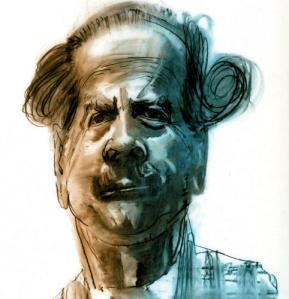“The medium is the message”. This term coined by communications theorist Marshal McLuhan almost half a century ago has never seemed more relevant than today. In the past twenty years, the digital revolution has given us new ways to access written and audio visual material via the web. With the rise of the internet, medium is increasingly influential on the content being produced and the message being conveyed to audiences. This medium has brought an emphasis on interactivity and audience participation like no other which has preceded it. The rise of citizen journalism has changed the roles of gatekeeper and consumer and this has had significant impacts on the messages audiences receive.
” The Medium is the Message” (Image source)
Not since the creation of the printing press has a new medium had so many personal and social consequences for the media and the dissemination of news. The rise of the newspaper not only enabled a permanent record of the news which could be mass produced to inform the people, but also found its place in upholding public opinion and keeping a check on democracy. For this reason, journalists found themselves as protecters of the Fourth Estate. Independence of the newspaper press from the three estates of government was an early example of medium directly affecting the messages that audiences receive. Similarly, the rise of the internet medium has enabled citizen journalism, a concept which has increasingly challenged the traditional role of the media as the ‘gatekeeper ‘of information.
The internet has transformed its citizens from passive consumers of news into active participants who can assemble their own content from separate elements. Audiences have become a hybrid of the consumer and producer, which has in turn encouraged people to question not only political institutions but the media themselves. The online community have begun to assume the role of a ‘fifth estate’, becoming the watchdog of the press and the governing powers. Media commentators Kovack & Rosenstiel commented that “This new era of sometimes obsessive self-consciousness is certainly healthy for democracy, as it awakens news audiences to some of the limitations of the news they already receive” (Kovach & Rosenstiel2007).
Realising the limitations of the media on the content we receive is important part of being a citizen journalist.We only have to look to the micro-bloggers in china to understand the importance of the internet as a medium which gives citizens back an uncensored voice. China has the most extensive and sophisticated media censorship control system in the world. However, censors have struggled to keep up with the flow of information on popular social media sites (Brannigan 2011). The speed at which news can spread on the internet has not only allowed users to evade the the controls of the ‘great fire-wall of China’, but to spread their messages around the world.
The internet medium has transcended time and space in a way we could have never imagined at the introduction of the print mass media. In the same way that the newspaper press created national community with its ability to reach the masses, the internet has transformed the world into the ‘global village’ which McLuhen himself predicted we would become. This has important implications beyond that of spreading messages over larger distances…it has enabled global awareness.
“The World is Now a Global Village” (Image Source)
The internet has encouraged a kind of global consciousness, as messages from around the world pervade our digital world. With the most recent example of the Kony2012 video, we have seen how in particular social media sites have had a particularly important role in promoting global awareness. Whatever your thoughts are on the Kony2012 campaign, there is no denying that it spread this issue to a much wider audience, using a medium which appealed to everybody in the western world in terms they could understand. Tahlia Palmer, writer for the local news website Cool Perth Nights commented that “I felt as if this campaign was the next step in our exploration of what the internet is capable of, the logical progression of social media activism after the Occupy Movement…It felt like this campaign was an important point in the history of the Internet” (Palmer 2012).
There has been lots of cynicism directed towards the idea of global awareness internet campaigns. Many believe that is is producing a generation of ‘couch activists’ who are quick to get on a bandwagon, but do little to actually help a cause. In terms of Kony 2012, perhaps the video can do little to help the Ugandan people who suffered under Kony’s tyranny. But by generating the interest, it encourages the research and these are important steps to enabling action. Perhaps the most important lesson it teaches us is that the internet is a medium which has encouraged consumers to think critically and engage in debate about the messages we receive.
Kony 2012- “Something We Can All Agree On” (Image Source)
Indeed the internet medium helped to create an audience who can engage with information and can respond carefully. Not only does the internet gives audiences access to platforms which allow debate with people from all over the world, but it has also become a medium that allows for audiences and professional journalists to interact in a way they have never been able to before.
In an increasingly digitised world, this convergence seems to be the future of journalism. What greater example of this is there than when BBC turned to citizens to bring the news to the nation after the London terrorist attacks. Within 6 hours the BBCreceived more than 1,000 photographs, 20 pieces of amateur video, 4,000 text messages, and 20,000 e-mails (Sambrook 2009). People were participating in new coverage in a way we had never seen and this became an integral part of how the BBC reported the day’s events. BBC reporter Richard Sambrook commented that “When major events occur, the public can offer us as much new information as we are able to broadcast to them. The reporting of this story was a genuine collaboration, enabled by consumer technology and supported by trust between broadcaster and audience. From now on, news coverage is a partnership” (Sambrook 2009).
Conversations between citizens and journalists have become increasingly important, in a world saturated with digital clutter. If anything, the ability for anyone and everyone to publish opinion as fact seem to make professional journalists more relevant. Professional journalists can critique internet sources and help audiences to verify what information is reliable and what is not. In this way it is helping arm the public with the tools it needs to perform this more active form of citizenship (Kovach & Rosenstiel2007). Many journalists who have gained credibility and respect through working in traditional media are doing this by creating a blog presence. Media commentator Jason Bainbridge explained that“The blogs of Australian journalist Margot Kingston operate in the same way that op-ed columns do in the traditional media, but significantly they offer a level of audience participation not possible in the traditional media formats” (Bainbridge et al 2008).
The significance of the internet is that it encourages an interactivity which alternative electronic mediums have not offered audiences. Other mediums such as television only allow us to receive messages as a linear experience. Furthermore, it is a linear experience that only allows for one way communication which leaves audiences with no opportunity to respond. Move the same content over to a website and the experience changes dramatically. Communication’s theorist Roger Logan explains “In the context of a website, information is rarely passed to the user as a linear experience. Instead information might all be split up into different pages or sections. It is up to the user to decide how to consume the information and reach a conclusion” (Logan 2010). This point itself is what underpins my article today. The very nature of the medium is what has encouraged citizen journalism to emerge as a force in today’s media.
You were right McLuhan, The medium really is the message.
“Convergence seems to be the future of journalism” (Image Source)
References
Bainbridge, Jason et al. (2008), Media & Journalism: New approaches to theory & practice, Oxford: Oxford University Press
Brannigan, Tania (2011) ‘China to step up social media censorship’, The Guardian Available from: <http://www.guardian.co.uk/world/2011/oct/26/china-social-media-censorship> [Retrieved 14/03/12]
Kovach, Bill & Rosenstiel, Tom (2007) , The Elements of Journalism, USA: Three Rivers Press
Logan, Robert (2010), Understanding New Media: Extending Marshall McLuhan, USA: Peter Lang Publishing
McLuhan, Michael (1964), Understanding Media. London: Routledge Classics
Palmer, Tahlia (2012), ‘On Kony 2012 and the Aftermath ‘, Cool Perth Nights Available at <http://www.coolperthnights.com/articles/steadyeye/366> [Retrieved 19/03/12]
Sambrook, Richard (2009), ‘Citizen Journalism and the BBC’, Nieman Harvard Foundation For Journalism. Available at < http://www.nieman.harvard.edu/reports/article/100542/Citizen-Journalism-and-the-BBC.aspx > [Retrieved 20/03/12]
Stephens, Michael (2007), A History of News. Oxford: Oxford University Press




